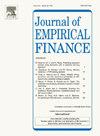跳跃尾部风险暴露与股票收益截面
IF 2.4
2区 经济学
Q2 BUSINESS, FINANCE
引用次数: 0
摘要
我们从期权价格中引入了一种新的跳跃尾部风险度量。我们根据股票对跳空尾部风险的敏感性来研究股票的横截面定价。我们发现跳尾风险的市场价格为负值。按跳跃尾部风险押注排序的高低组合每年产生-9.95%的负溢价,这在统计和经济学上都是显著的。风险调整后的回报也是负的,而且非常显著。我们发现,负的跳跃尾部风险溢价主要是由其下行跳跃尾部风险部分驱动的。相反,按上行跳空尾部风险押注排序的高低组合的溢价并不显著。在控制了各种风险因素负载和公司特征后,下行跳空尾部风险的负溢价是显著的,而且对大型公司来说仍然很强。我们的结果还可以用于预测环境,即比较按上期估计的下行跳跃尾部风险押注排序的五分位投资组合的后续实现回报。本文章由计算机程序翻译,如有差异,请以英文原文为准。
Jump tail risk exposure and the cross-section of stock returns
We introduce a new jump tail risk measure retrieved from option prices. We examine the cross-sectional pricing of stocks according to their sensitivities to jump tail risk. We find a negative market price of jump tail risk. A high-low portfolio sorted by jump tail risk betas delivers a statistically and economically significant negative premium of -9.95% per year. Risk-adjusted returns are also negative and highly significant. We document that the negative jump tail risk premium is mainly driven by its downside jump tail risk component. On the contrary, the premium of the high-low portfolio sorted by upside jump tail risk betas is insignificant. The negative premium of downside jump tail risk is significant when controlling for various risk factor loadings and firm characteristics, and remains strong for large firms. Our results carry over to a predictive setting, in which we compare subsequent realized returns of the quintile portfolios sorted by downside jump tail risk betas estimated over the previous period.
求助全文
通过发布文献求助,成功后即可免费获取论文全文。
去求助
来源期刊

Journal of Empirical Finance
Multiple-
CiteScore
3.40
自引率
3.80%
发文量
59
期刊介绍:
The Journal of Empirical Finance is a financial economics journal whose aim is to publish high quality articles in empirical finance. Empirical finance is interpreted broadly to include any type of empirical work in financial economics, financial econometrics, and also theoretical work with clear empirical implications, even when there is no empirical analysis. The Journal welcomes articles in all fields of finance, such as asset pricing, corporate finance, financial econometrics, banking, international finance, microstructure, behavioural finance, etc. The Editorial Team is willing to take risks on innovative research, controversial papers, and unusual approaches. We are also particularly interested in work produced by young scholars. The composition of the editorial board reflects such goals.
 求助内容:
求助内容: 应助结果提醒方式:
应助结果提醒方式:


